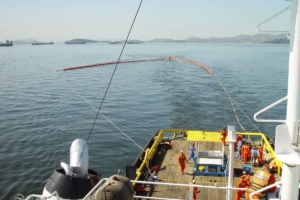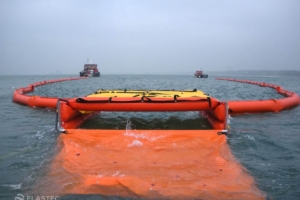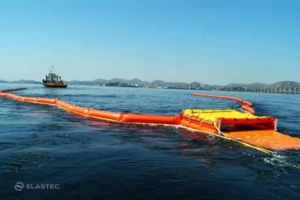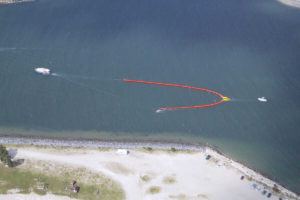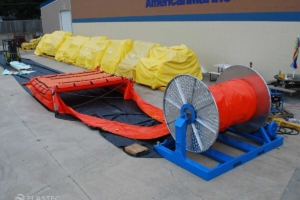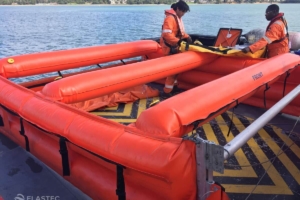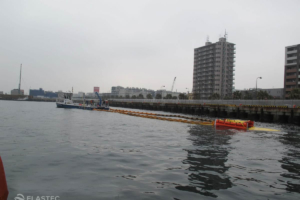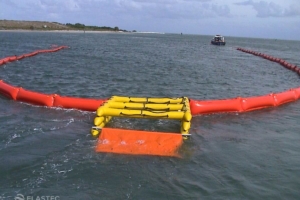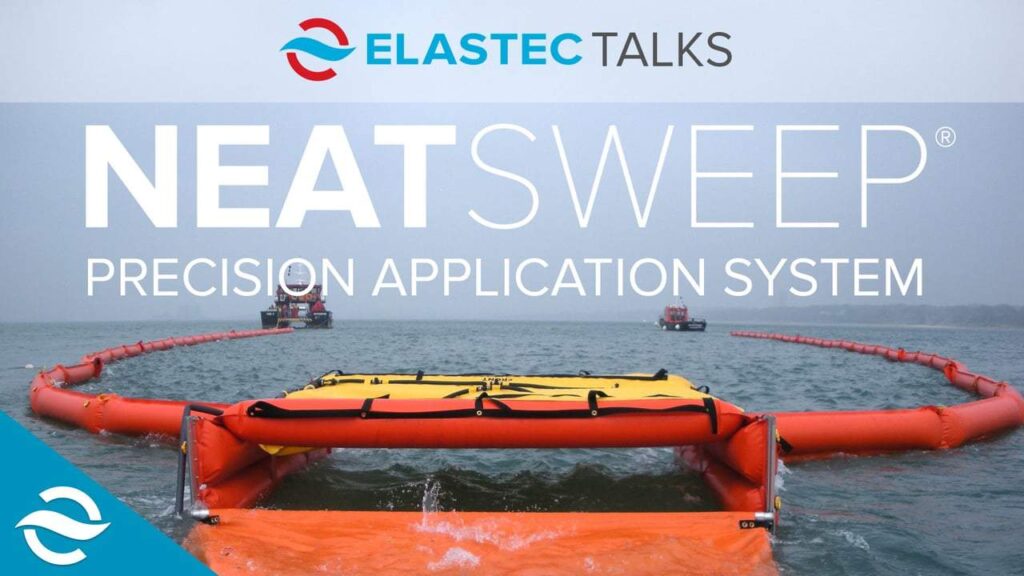NEATSWEEP
The patented Elastec NeatSweep® is a precision dispersant application system that targets oil by funneling it into the Dispersant Application Zone (DAZ) where it is applied neat (undiluted). By adding an Elastec BoomVane™, this innovative system can also be operated with a single vessel. Read our Frequently Asked Questions.
A computerized monitoring system controls the rate of dispersant application, reducing waste. It senses the speed of the system through the water and self-adjusts the pumping rate. Oil enters the dispersant application zone (DAZ) at uniform thickness allowing more precise dosing and targeting.
The system includes two sections of AirMax boom, computerized oil spill dispersant pumping unit, dispersant application unit and mixing panel. This system allows the neat (full concentration) application of oil spill dispersant directly onto the oil. As the setup is more efficient, more oil can be treated with each deployment. Most importantly, the system operates at a safe distance from operators, reducing their exposure to wind-blown chemicals.
Independent tests at Ohmsett confirm efficiency of up to 92%.
Contact us to learn more.
NEATSWEEP® PHOTOS
NEATSWEEP® VIDEO
Oil Dispersant Application System Frequently Asked Questions
What is an oil spill dispersant?
“Dispersants” as they are known generically are low toxicity chemicals that are used to break up oil on the surface of the water and promote natural degradation. They are a tool used alongside mechanical recovery and in-situ burning.
When are dispersants used?
Dispersant is typically used in large scale incidents offshore when other means are limited. Responders will go through a net environmental benefit analysis.
Where is it used?
Dispersant is not typically used in shallow or inland waters.
How is it applied?
Dispersant has to be sprayed in the correct manner to ensure effectiveness. It may be sprayed from aircraft or ships.
Does dispersant usage have to be approved?
Yes. The use of oil dispersants is regulated in most countries. Not only does the use need to be approved, the chemical itself has to undergo testing for toxicity and effectiveness.
Products Available for Use During an Oil Spill
Dispersant use approvals in the United States
What dispersant spray systems does Elastec offer?
We have three different systems, Elaspray is a conventional pump and arm setup, with arms that are mounted to the side of a ship. The Neatsweep is more precise as oil is funneled to a channel where the oil dispersant is applied ( dosage automatically adjusts to the speed of the vessel ), and the Boom Vane Spray (BVS). The BVS system enables vessels to get closer to shore with a wider swath than arms.
ASTM Standards for Oil Spill Dispersants
The following links offer information related to ASTM International standards for oil spill dispersants.
- F1209-19 Standard Guide for Ecological Considerations for the Use of Oil Spill Dispersants in Freshwater and Other Inland Environments, Ponds and Sloughs
- F1210-19 Standard Guide for Ecological Considerations for the Use of Oil Spill Dispersants in Freshwater and Other Inland Environments, Lakes and Large Water Bodies
- F1231-19 Standard Guide for Ecological Considerations for the Use of Oil Spill Dispersants in Freshwater and Other Inland Environments, Rivers and Creeks
- F1413/F1413M-18 Standard Guide for Oil Spill Dispersant Application Equipment: Boom and Nozzle Systems
- F1460/F1460M-18 Standard Practice for Calibrating Oil Spill Dispersant Application Equipment Boom and Nozzle Systems
- F1737/F1737M-19 Standard Guide for Use of Oil Spill Dispersant Application Equipment During Spill Response: Boom and Nozzle Systems
- F1738-19 Standard Test Method for Determination of Deposition of Aerially Applied Oil Spill Dispersants
- F1872-17 Standard Guide for Use of Chemical Shoreline Cleaning Agents: Environmental and Operational Considerations
- F2059-17 Standard Test Method for Laboratory Oil Spill Dispersant Effectiveness Using the Swirling Flask
- F2205-19 Standard Guide for Ecological Considerations for the Use of Chemical Dispersants in Oil Spill Response: Tropical Environments
- F2465/F2465M-20 Standard Guide for Oil Spill Dispersant Application Equipment: Single-point Spray Systems
- F2532-19 Standard Guide for Determining Net Environmental Benefit of Dispersant Use
- F3251-17 Standard Test Method for Laboratory Oil Spill Dispersant Effectiveness Using the Baffled Flask
